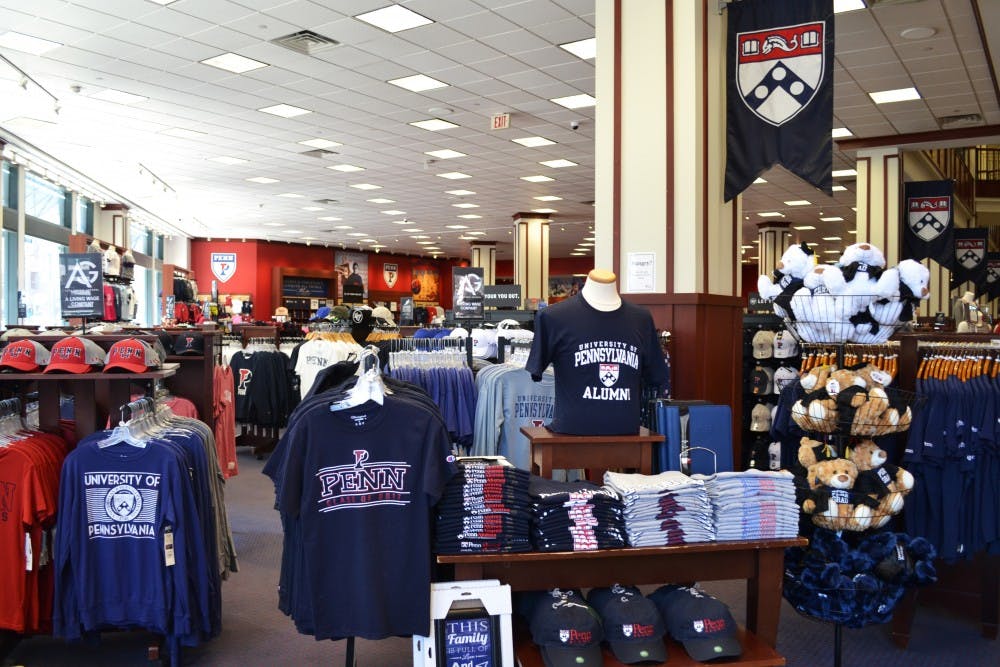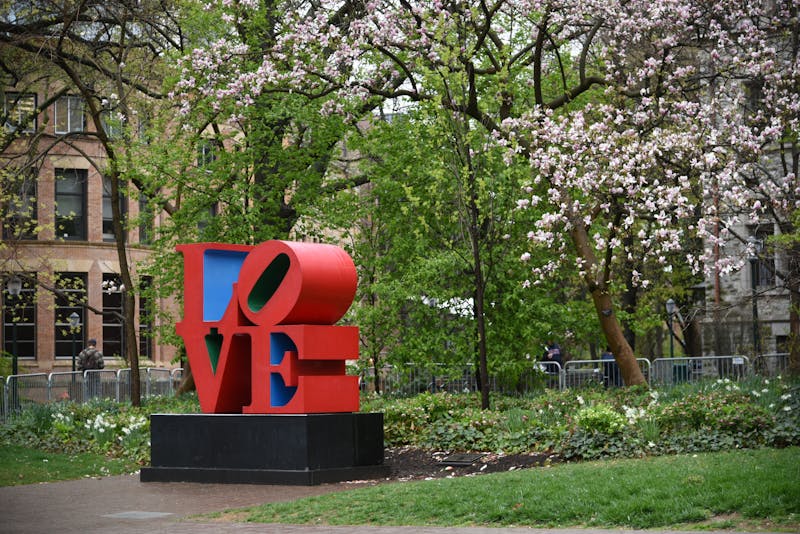
Walking down Locust Walk, it is not uncommon to see fellow Quakers sporting Penn apparel. And while the University undoubtedly supports the public display of "Penn pride," the process of licensing Penn's logo — whether it be for sweatshirts, hats, t-shirts, or any other trinkets — comes at a cost.
Currently, 120 vendors are licensed to sell Penn merchandise, including the University of Pennsylvania Bookstore at 36th and Walnut streets and various other stores or online platforms. In order to sell items with the Penn logo, vendors must apply to the University for a license. Upon receiving a license, the vendor then must pay Penn a 10 percent royalty fee of the item’s wholesale cost.
While this is a common practice at many institutions, at Penn, part of this royalty fee goes toward the pool of financial aid.

According to Associate Vice President for Business Services Christopher Bradie, the decision to use profits from logo licensing for financial aid was established before Bradie began working for Penn Business Services Division in 2000.
“The revenue derived from [licensing] has an important purpose, which is how we earmark our money,” Bradie said. “Different schools might use money for different things, but [financial aid] is how we use ours.”
Director of Communications in the Division of Finance Paul Richards said that he is also not familiar with the history of this arrangement, though he emphasized that licensing profits are a very small portion of financial aid’s $224 million undergraduate budget.
“The vast majority of financial aid funding comes from other sources on campus such as the University’s operating budget and endowed scholarship funding,” Richards said.
For merchandise items containing the Penn Athletic crest, though, the money goes toward Penn Athletics, Bradie noted.
Richards and Bradie declined to disclose the exact amount licensing fees contributed to financial aid and Penn Athletics, respectively.
“The money that Penn Athletics receives from licensing is re-invested within the Division of Recreation and Intercollegiate Athletics to support our varsity programs and student-athletes,” spokesperson for Penn Athletics Kevin Bonner said in an emailed statement to The Daily Pennsylvanian.
Assistant Director of Communications and External Relations Annie Weinstein is one of the members of the Penn administration who helps ensure that vendors who approach the University adhere to its manufacturing guidelines.
Weinstein said that the process to become a licensed Penn vendor is not “prohibitively difficult,” and that most vendors receive a license if they meet requirements about presentation of the logo itself and follow the manufacturing code of conduct.
According to Bradie, many of these requirements have to do with the aesthetics and appropriate presentation of Penn's logo, including factors as simple as making sure the official Penn logo is intact on the product.

Bradie also stated that the University is strict about vendors adhering to the manufacturing code of conduct, which was first published in March 2000. The Committee on Manufacturer Responsibility, made up of undergraduate and graduate staff, reviews companies with Penn licenses to ensure that Penn’s logo is affiliated with companies that have high labor standards. The committee relies on two agencies, the Fair Labor Association and the Workers’ Rights Consortium, to monitor licensee’s behavior.
Penn monitors whether or not a company applying for a merchandising license adheres to the Bangladesh Accord, a fire and building safety agreement issued in 2013, Bradie said.
“In general, attention to social responsibility in labor conditions is not exclusively a college and university issue,” Bradie said. “If collegiate clothing is being produced in a factory, there’s a very good chance that factory has a high labor standard in general, because they know that there’s the monitoring agencies.”
However, once Penn issues a logo license, they are not involved in setting a product’s retail price, or in deciding which retail outlet the vendor sells its items through. Penn does have a contract with Barnes & Noble to operate the University bookstore, though vendors deal directly with Barnes & Noble and other retail outlets to sell merchandise.
"The connection between [Barnes & Noble and licensing] is that all the branded products in the [Penn] bookstore are required to be sourced from licensed vendors," Director of Communications and External Relations for Penn Business Services Division Barbara Lea-Kruger said in an emailed statement to The Daily Pennsylvanian. "The products are produced in a socially responsible manner in line with Penn’s social responsibility guidelines."
Penn student groups must also follow these licensing rules if they plan to use a trademarked name or logo on their apparel.
Freshman Class Board President and Wharton and Engineering freshman Moksh Jawa said that he had to use a company with a University license when making shirts featuring the Wharton name, which ended up being more expensive.
Class Board also created shirts for Penn's undergraduate schools, associating each with a Hogwarts House from the Harry Potter book series. Although the shirts did not include the official Wharton logo, the Class Board had to use a University-approved vendor.
"Originally we were planning on going with a different company, but that company was not on Penn’s official list," Jawa said.
Custom Ink, the University-approved vendor Class Board ended up using, was around $3 more expensive than the unapproved vendor Fresh Prints.
If BSD comes across an unlicensed vendor on the Internet, they will usually reach out and ask the vendor to become licensed. Bradie said that the University used to have problems with unlicensed vendors coming to campus to sell products out of garbage bags during Penn Relays, but have since tightened security.
“College and University markets are just different," Bradie said. "If you’ve got our logo on it, we tell people, and it’s a promise, that we have some due diligence around understanding what that chain of delivery was.”
Bradie said the University’s main motivation in licensing out logos is to enable anyone associated with Penn to show off the Red and Blue.
“That whole connectedness of allowing people to express their affinity, it’s really big in the collegiate market, and Penn is no exception to that,” Bradie said. “So I think that the main driver is for that brand identity, and that’s really important.”
The Daily Pennsylvanian is an independent, student-run newspaper. Please consider making a donation to support the coverage that shapes the University. Your generosity ensures a future of strong journalism at Penn.
Donate







